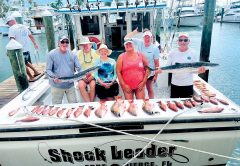
[dropcap]T[/dropcap]he roar of Florida flavored, winter winds will continue to shape the offshore seascape and fishing grounds of Martin County, Florida this March. While the arrival of cold fronts and low pressure systems that possess high velocity winds are no surprise and typical for the inaugural days of this month, these offshore weather making events will also be influenced by the strong “El Nino” component, which will remain in place and enhance the duration and frequency of these frontal systems and maintain an open window for similar weather events throughout March. This will translate into rough and choppy sea states for deep sea fishermen, who will find fish friendly weather windows to be erratic and brief. Staying on top of daily offshore forecasts (National Weather Service Marine Forecast) and other near coastal reference points (NDBC – Station 41114 Recent Data | St. Lucie Inlet Web Camera | Jensen Beach Webcam ) will allow local saltwater fishing aficionados to dial in an offshore window that appears user friendly for one`s recreational fishing adventures. As offshore anglers make their way through open weather windows, east of the St. Lucie Inlet, saltwater enthusiasts will find a solid body of cobia populating the near coastal zone. Wrecks and reefs from 50-to-100-feet are favorite haunts for this hard fighting (and tasty) gamefish and can be hooked and caught on a wide variety of baits and tackle presented at all depths in the water column.

Moreover, cobia are frequently seen free-swimming on the surface and also have a tendency to swim alongside larger sea creatures, like manta and sting rays, sharks, and turtles. Casting a 3-to-4-ounce artificial jig to a free-swimming or trailing cobia typically has a high rate of success for a “bite”, while tossing a live bait—greenies, sardines, blue runners, and grunts—usually proves to be irresistible to a “hungry cobe.”
East of Stuart, there are some fishing spots that are better than others for cobia, with there being a half dozen “go-to” reef structures that historically hold larger numbers of cobia than other spots (when the fish are in the zone). However, any reef structure in similar depths and proximity are equally as likely to be holding a few representatives and with this in mind, anglers should be encouraged to prospect at these other (less angler frequented) reef locations, especially as the more popular reef spots get covered up and crowded by too many boats with “Cobia Fever”. Finding one`s own fishing spot that produces success away from the fleet is always more rewarding in the long run.
March will be a multi-layered weather platform for offshore anglers, that watch winter, ever so slowly change into spring during the month`s latter days and will find cobia as the sought after prize on the eastern side of our inlet`s open window.
[easy-social-share]




